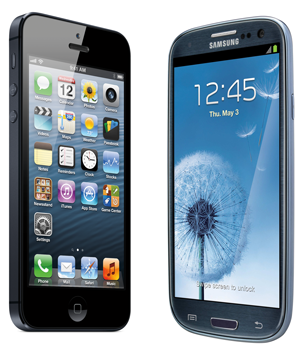iPhone 5 Vs. Galaxy S3: Which Users Engage With More Ads?
- Fahad H

- Jun 10, 2013
- 3 min read

Image courtesy of Apple & Samsung
With over 27.4 million iPhone 5s sold in the last quarter of 2012 alone, the iPhone 5 is the world’s best-selling smartphone according to a recent report by Strategy Analytics, with its sales figures far outstripping those of previous iPhone models.
The Samsung Galaxy S3, though it lags behind the iPhone in sales, put in a very strong performance during 2012 – it was the best-selling smartphone worldwide until early this year when the iPhone 5 eclipsed it.
But, sales figures aren’t the only important numbers marketers need to consider when contemplating an online campaign. The share of mobile Web usage generated by these devices, and the behavior of those users, are also important metrics.
In North America, where the advertising market is largest, the Chitika online advertising network looked into the Web usage share between the iPhone 5 and the Galaxy S3.
That study found, despite the much heavier worldwide sales of the iPhone 5 in the U.S. and Canadian market, the Galaxy S III shows comparable usage levels to the iPhone 5. The traffic generated by the two phones had a near 50/50 split – a very slight lead was held by the iPhone 5, but the difference was minor.
With both these phones being such heavy hitters in the mobile world, understanding user engagement with advertisements on both these models can help marketers optimize their online campaigns and advertising efforts.
To provide insight into this dynamic, Chitika conducted a study into user engagement with ads on both the Galaxy S III and the iPhone 5, looking to see how each of these popular phones’ users diverged when it comes to online ad-related behavior.
iPhone 5 Vs. Galaxy S3
For the purposes of this study, Chitika examined a sample of tens of millions of online ad impressions collected from the Chitika advertising network. The sample used in this study was taken across the week of May 18th to May 24th, 2013. A user agent analysis was then used to isolate impressions generated by the Galaxy S3 and the iPhone 5.
The click-through rate (CTR) for both these phones is one of many metrics used to gauge the difference in how users of both these devices engage with content on the Web. Targeting demographics with higher CTR can be crucial to driving interaction within a campaign.

Based on the above graph, users on the Galaxy S3 exhibited a value of 0.87 on the CTR Index. The iPhone 5, by comparison, had value of 1 on the CTR index. This means that users on a Galaxy S3 are 87% as likely to click on an ad as a user on an iPhone 5. The iPhone 5 users were engaging with ads a full 15% more often than users of the Galaxy S3.
Given the impact of both these phones in the mobile market, it is important for marketers and publishers alike to have a comprehensive picture of performance when engaging in online campaigns.
Both these phones have overwhelmingly high sales figures. Both have comparably high usage, driving large amounts of traffic across the North American market. These metrics make both of them quite appealing advertising targets for marketers.
The higher performance of advertisements on the iPhone 5, combined with its higher market share overall, makes it a more promising target for marketers looking to gain exposure to their mobile audience.
Studies like this can help advertisers form a good idea of the right angles to take when targeting their online campaigns. Targeting not just the largest markets but also the most engaged markets can help improve advertising performance and allow marketers to achieve the highest ROI on their mobile marketing campaigns.








Comments